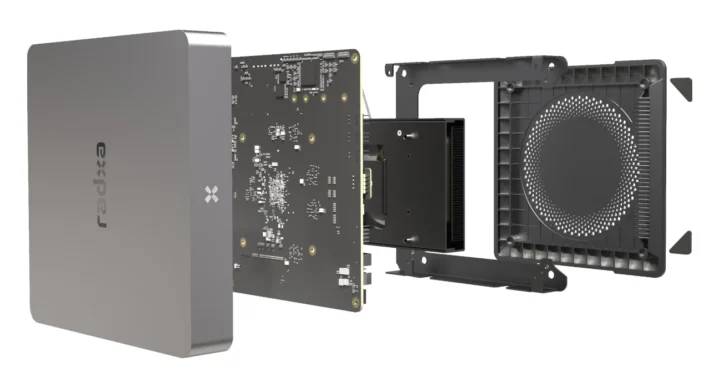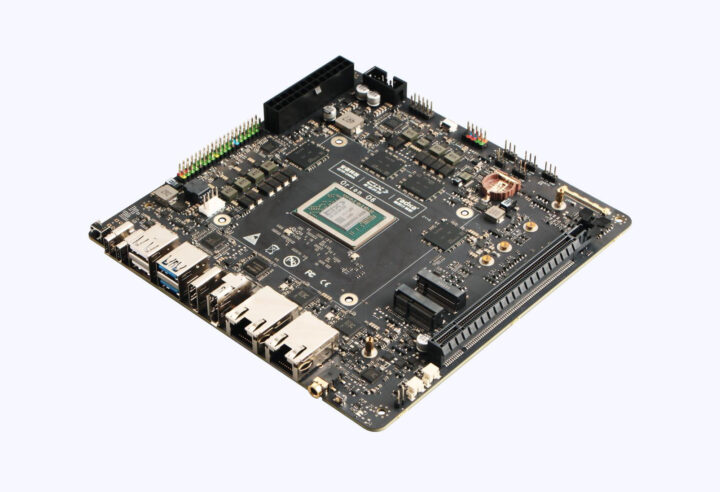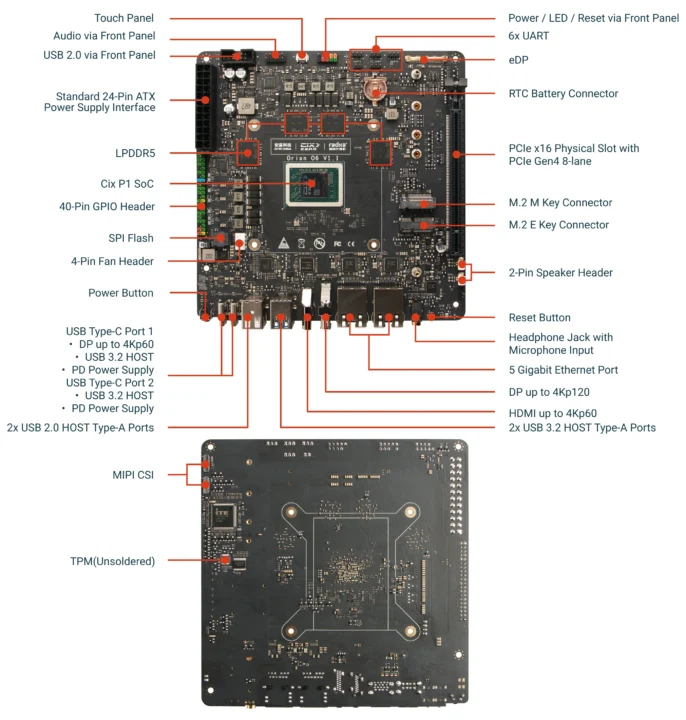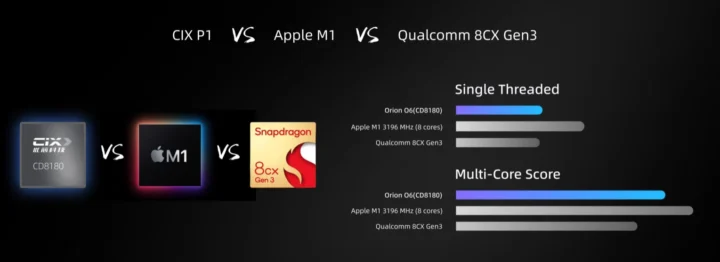Radxa Orion O6 is an Arm mini-ITX motherboard with performance similar to Apple M1 and Qualcomm 8cs Gen3 platform thanks to the Cix P1 12-core Armv9 processor with four Cortex-A720 cores clocked at 2.8 GHz, four Cortex-A720 cores at 2.4GHz, and four low-power Cortex-A520 cores clocked at 1.8 GHz.
The Cix P1 SoC also features an Arm Immortalis-G720 GPU for graphics and AI computing, a 30 TOPS AI accelerator for a combined 45 TOPS of AI inference performance, an 8Kp60 video decoder, and an 8Kp30 video encoder. The Orion O6 SBC ships with up to 64GB LPDDR5, features a 4Kp60 HDMI 2.0 port, a 4Kp120 DP 1.4 connector, two 5Gbps Ethernet ports, M.2 socket for storage and wireless, a PCIe x16 slot, and more.
Radxa Orion O6 specifications:
- SoC – Cix P1 (Codename: CD8180, not the CP8180 variant for AI PCs)
- 12-core DynamIQ processor
- 4x CortexA720 big cores @ up to 2.8 GHz
- 4x CortexA720 medium cores @ up to 2.4 GHz
- 4x CortexA520 LITTLE cores @ up to 1.8 GHz
- Cache – 12MB shared L3 cache
- GPU – Arm Immortalis G720 MC10 with hardware ray-tracing support, graphics APIs: Vulkan 1.3, OpenGL ES 3.2, OpenCL 3.0
- VPU
- Video Decoder – Up to 8Kp60 AV1, H.265, H.264, VP9, VP8, H.263, MPEG4, MPEG2
- Video Encoder – Up to 8Kp30 H.265, H.264, VP9, VP8
- AI accelerator – Up to 30 TOPS Neural Processing Unit (NPU) with support for INT4/INT8/INT16, FP16/BF16, and TF32
- Manufacturing Process – TSMC 6nm
- 12-core DynamIQ processor
- System Memory – 8GB, 16GB, 32GB, or 64GB 128-bit LPDDR5 @ 5500 MT/S (100GB/s bandwidth)
- Storage – M.2 MKey (PCIe Gen4 x4) socket for NVMe SSD
- Display Outputs
- HDMI 2.0 port up to 4Kp60 (HDMI CEC not supported)
- DisplayPort 1.4 up to 4Kp120; MST (MultiStream Transport) support; dualstream capability
- USBC with DisplayPort Alt Mode
- eDP connector with built-in touchscreen support up to 4Kp60
- Support for up to 4x displays
- Audio
- 3.5mm combo audio jack with 32Ω headphone drive capability, integrated microphone input
- Audio Header for HD Audio front panel connector; standard PC case audio support
- Camera I/F – 2x MIPI CSI connectors configurable as 4lane or 2lane MIPI CSI each
- Networking
- 2x Multigigabit 5Gbps Ethernet RJ45 ports supporting 10/100/1000/2500/5000 Mbps speeds
- Optional WiFi 7/6E + Bluetooth module via M.2 EKey socket (PCIe Gen4 x2 + USB)
- USB
- USB 3.2 Gen 2 (10Gbps) Type-C port with Power Delivery
- USB 3.2 Gen 2 (10Gbps) Type-C port with DP Alt Mode (4Kp60) and Power Delivery
- 2x USB 3.2 Gen 2 (10Gbps) Type-A ports
- 2x USB 2.0 Type-A ports
- USB header with 2x USB 2.0 interfaces
- Expansion
- M.2 Key-M (PCIe Gen4 x4) socket for NVMe SSD
- M.2 Key-E (PCIe Gen4 x2+ USB) for wireless module
- PCIe x16 slot carrying PCIe Gen4 x8 signals for graphics cards and other PCIe devices
- 6x UART via headers
- 40-pin color-coded GPIO header with 3x UART, 2x I2C, 2x I2S, 2x PWM, 1x SPI, 10x GPIO
- Debugging – Serial console header; system monitoring sensors
- Misc
- 4pin CPU fan header with smart PWM control
- Fan speed monitoring via TACH
- 75x75mm heatsink mounting holes
- System control for Power and Reset buttons, status LED indicators
- RealTime Clock with backup battery holder (CR1220)
- Power Supply
- 24pin ATX power connector
- 20V via USB-C port (65W at least)
- Only one power source can be used
- Dimensions – 170 x 170mm (Mini-ITX form factor)
- Longevity – Availability guaranteed until at least September 2029.
On the software front, we are told the board supports Debian Linux distributions and full UEFI via EDKII. BSP and SDK are available with hardware and software documentation, community forum support, regular firmware & OS updates, and an opensource BIOS / EDKII and Linux kernel. None of that is available online right now as the Orion O6 was just unveiled in China. Binary releases will start on January 15, 2025, and the source code will be released later in Q1 2025. Some document also shows support for Fedora, and soon Ubuntu, Android, Deepin, Windows, and OpenKylin.
(Geekbench?) Benchmarks results released by the company show the Orion O6 matches the single-core performance of the Qualcomm 8CX Gen3 and getting close to the mult-cire score of a machine with an 8-core Apple M1 processor clocked at 3196 MHz.
Besides the mini-ITX motherboard, Radxa also plans to offer an AI PC Kit with enclosure in February/March 2025, and after that, a CIX P1 COM Express module with LPDDR5 and 16-lane PCIe Gen4 interface.

The Orion O6 mini-ITX motherboard is available for pre-order in four variants:
- 8GB RAM for $199
- 16GB RAM for $239
- 32GB RAM for $299
- 64GB RAM for $449
That’s certainly quite cheaper than Apple M1 or Qualcomm Snapdragon 8cx Gen3 alternatives. The AI PC Kit (enclosure) sells for $39. You can pre-order the Radxa Orion O6 mini-ITX motherboard and kit on Arace and soon on AliExpress (note: if the Aliexpress link does not show it’s your ad blocker). Additional information may be available on the product page.

Jean-Luc started CNX Software in 2010 as a part-time endeavor, before quitting his job as a software engineering manager, and starting to write daily news, and reviews full time later in 2011.
Support CNX Software! Donate via cryptocurrencies, become a Patron on Patreon, or purchase goods on Amazon or Aliexpress







